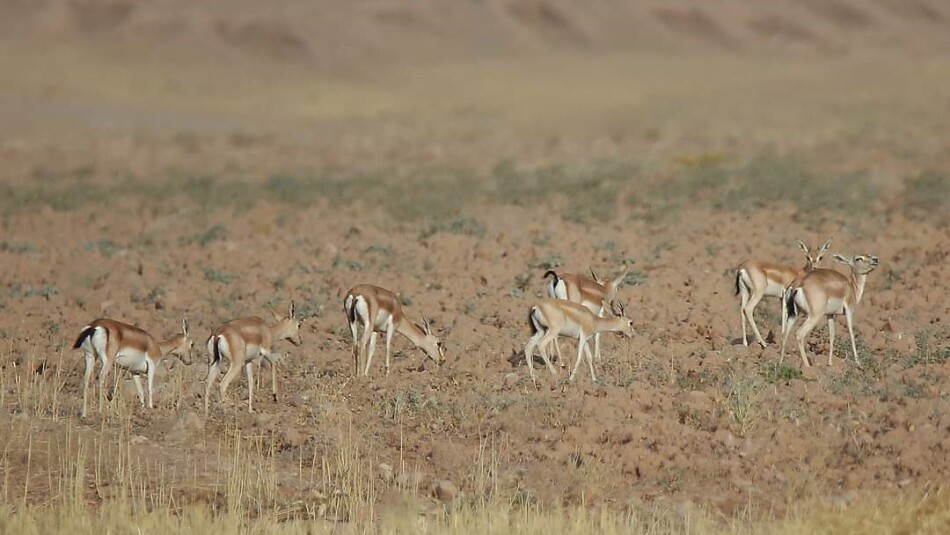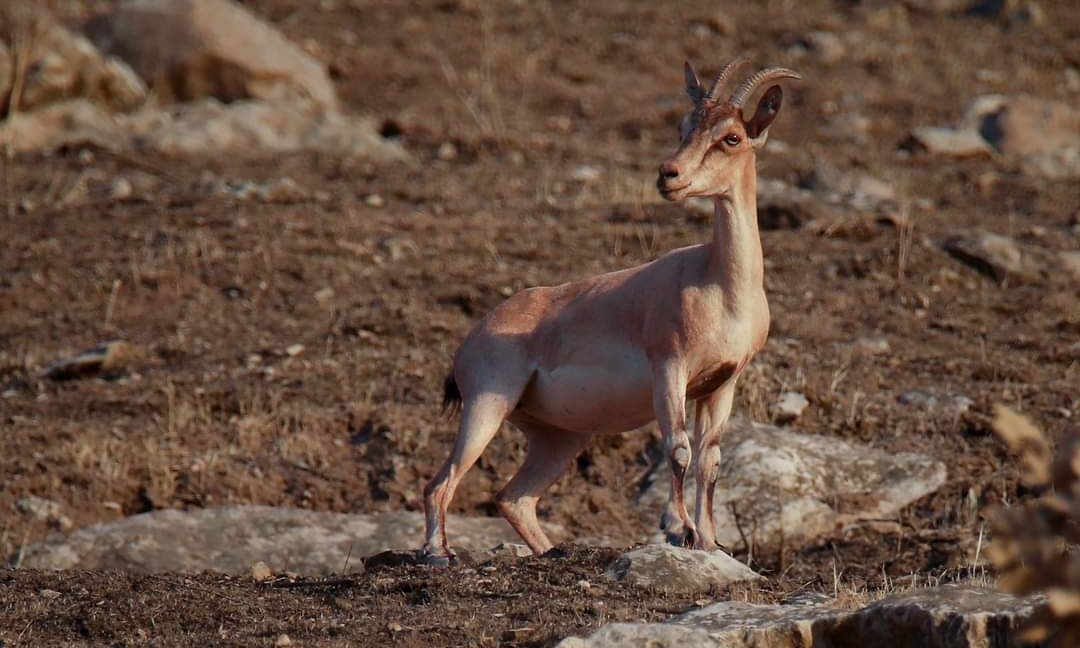
Nemat Malo experiences joy when he sees gazelles and other wild animals roaming the hills and plains of Garmiyan, a sight he had never witnessed before in his entire life.
Six years ago, Malo announced the launch of an initiative to protect wild animals, which he believes, among dozens of other initiatives, has achieved what was required.
Malo, a photographer, leads a group called Kyodostan to protect wild animals in Garmiyan local administration under Sulaymaniyah Northern Province. Malo co-founded the group with three other young men in 2018.
“We observed a decline in the number of wild animals in Garmiyan.”
It all began with a video
Before 2018, as water sources in the areas under the Garmiyan administration gradually dried up, Malo filmed a video showing a wild gazelle drinking water from a spring with extreme caution and suspicion.
The video circulated on social media and elicited many reactions, “prompting the government to provide water to wild gazelles in several areas,” according to Malo.
He mentioned that before the video went viral, several deer had gone “blind from thirst,” and many had migrated east toward the Iranian border.
The Garmiyan administration includes the districts of Kalar, Kafri, and Darbandikhan. The area is characterized by plains, hills, and mountains, and the Sirwan River runs through it, making it conducive for wildlife to thrive.
Deer are among the animals widespread in the area due to the availability of pastures and multiple water sources.
The numbers of deer and other wild animals have decreased over the past decade due to the repercussions of climate change, before several organizations launched various initiatives to protect wildlife.
One of the initiatives is the Kyodostan Group. The four members of the group capture and publish photographs and videos of wild animals to raise awareness among citizens about the importance of preserving the natural environment of the region and refraining from hunting them.
“This initiative arose after wildlife in the Garmiyan areas faced danger due to drought and lack of pastures, and there was a neglect of wildlife,” Malo added. “The four of us decided to establish a volunteer group with a mission to protect wildlife and the natural environment of the region.”
Nemat explained that "publishing documentaries about wild animals is to inform the relevant authorities that these animals exist and to urge them to protect them." The Kyodostan group sometimes showcases documentaries on certain occasions to convey their message to the largest number of people.
The group is active on social media and showcases its documentaries and other works on the Kyodostan page.
The Garmiyan gazelle at the forefront of the initiative
There are about 15 species of wild animals in the Garmiyan plains, most notably the gazelle, wild cat, fox, wolf, boar, jackal, porcupine, rabbit, and others that have become part of the region's environment.
The goitered gazelle is one of the species that the Kyodostan group is working to protect. Malo mentions that the goitered gazelle is only found in the Garmiyan plains and is also known as the Garmiyan gazelle.
According to statistics from the Garmiyan Environmental Protection Organization, this species of gazelle has declined by 85% in the past three decades.
The female goitered gazelle does not have horns, and the males are distinguished by the swelling on their necks.
"The group's primary concern is to prevent the extinction of this wild animal because it is a rare species,” Malo states.
Khalil Ahmad (51 years old), who has been herding livestock for 20 years in the village of Balchaftia within the borders of the Qoratw sub-district in Garmiyan, says, "What I have witnessed in the past two years regarding wild animals has been unprecedented. The deer have started to appear publicly. I come across groups of deer on the mountain slopes once or twice a month. Sometimes they even approach homes. The villagers do not harm them, and they roam without fear."
Another activity of the Kyodostan group is raising awareness about protecting wildlife through seminars and placing road signs.
"Many road signs and warnings are placed regarding the prohibition of hunting wild animals and their preservation... The appearance of deer is partly attributed to the activities of the Kyodostan group and partly to the awareness of the population," Khalil said but he pointed out that "hunting operations are still being practiced."

Challenges facing Kyodostan
Poaching is one of the major challenges facing the Kyodostan group, directly leading to a decline in wildlife numbers.
Illegal hunting is a common phenomenon in the Garmiyan areas, to the point that a judge has been assigned to the Garmiyan Court of Appeal to handle cases related to poaching.
According to statistics published by the Garmiyan Forest and Environment Police Directorate, 147 people were arrested on charges of illegal hunting and logging during 2023, while the number of cases recorded in 2022 was 110 violations.
Hashim Ali, the spokesman for the directorate, said, "This year, cases of poaching have decreased due to the strict measures we take against violators," without having accurate statistics.
Kyodostan is one of the main reasons behind the improvement in the wildlife situation in the region
"We appreciate the efforts of the Kyodostan group in this regard... The group's activities are more related to the Khanaqin section of the directorate, but it is an active group and helps us in doing our work," he added, noting that Kyodostan "is one of the main reasons behind the improvement in the wildlife situation in the region, as its members are responsible for raising awareness among residents about the dangers of the extinction of wild animals."
The Environmental Protection and Improvement Law in the Kurdistan Region of Iraq KRI prohibits hunting, killing, detaining, transporting, or selling birds and animals that are at risk of extinction.
The applicable laws in the KRI set penalties for perpetrators of environmental violations, which are imprisonment for a period of not less than three months and a fine ranging from one million Iraqi dinars IQD (USD670) to 20 million IQD, or one of the two penalties.
Regarding the regulation of wildlife in the laws in force in the Kurdistan Region, the instructions allow the regulation of hunting and the use of forests within a specific legal framework.
The instructions of the Environmental Protection and Improvement Authority for the year 2021 regarding hunting animals and birds state, "The hunter must have a legal hunting license and adhere to the conditions of the license under which the types of birds and animals were determined, hunting season, the number of animals allowed to be hunted, and the type of weapons allowed to be used for hunting.
However, hunting endangered animals is strictly prohibited, and penalties are imposed for hunting them, including tigers, deer, wild goats, bears, hyenas, and some other species.
A report by the United Nations Development Program UNDP published in May 2023 indicates that several species of wild animals and reptiles are threatened with extinction in northern Iraq, including the Persian leopard that lives in the mountains of northern Iraq.
"Some do not cooperate with us; they destroy surveillance cameras, sometimes hunters deliberately obstruct our access to some areas to monitor wildlife," according to Malo.
He also stressed that members of his group, although they have licenses that allow them to visit all areas of Garmiyan to complete documentary work, are often prevented because they are not recognized or believed.
The population of Garmiyan administration is estimated, according to statistics from the Garmiyan Statistics Directorate, at about 343,000 people. In addition to wild animals, there are rare species of birds in the region, the preservation of which has become part of the tasks of Kyodostan.
Sandgrouse, ducks, geese, black chickens, owls, storks, kingfishers, and crows are examples of dozens of bird species that live in the Garmiyan environment.
According to a report prepared by the Nature Iraq organization in 2011, hunting in the Kurdistan Region is still the main source of income for many villagers and even city dwellers, leading to "the extinction of many species of wild animals."
"In the current situation, we cannot expand the scope of our group's work because we do not have financial capabilities, although we have big plans for the future," Malo complained.
"Perhaps if we get financial support, we will have a greater impact on raising awareness among citizens," he added
However, Malo stressed, "We will not stop until we achieve our goals."